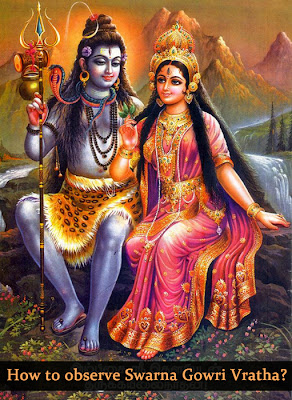Ganesha Chaturthi or Vinayaka Chaturthi is one of the most colorful and widely celebrated festivals in India. Large number of people observe Ganesha Chaturthi poojas at home. Here is an explanation on how to perform Ganesha puja at home as mentioned in Hindu scriptures.
Ganesha puja on the Chaturthi day is usually performed at noon but nowadays people perform it when all the family members are present.
Requirements
- A Clay image of Lord Ganesha.
- Red flowers
- Druva Grass blades
- Modak (jaggery filled sweet)
- Coconut
- Red chandan (Sandalwood paste)
- Incense and agarbathis
The Puja
- First clean the house and take a bath.
- A Clay image of Lord Ganesha is installed in a raised platform.
- Pray to Lord Ganesh and you can recite mantras or bhajans dedicated to Lord Ganesha.
- Next step is to invoke Ganesha into the image. This is known as pran-prathishta. The Pran Prathista mantra in Sanskrit to be invoked is found in the Rig Veda and is part of Ganesh Suktha.
ganananh tva ganapatim havamahe kavim kavinam - upamashravastamam |
jyeshhtharajam brahmanan.h brahmanaspata A nah shrivnvannutibhih sida sadanam ||
(Rig Veda 2.23.1)
ni shhu sida ganapate ganeshhu tvamahurvipratamam kavinam |
na rite tvat.h kriyate kinchanare mahamarkam maghavan.h chitramarcha ||
(Rig Veda 10.112.9)
We invoke You, O Ganapati of the ganas (Lord Shiva attendants), Who are Brahmana-spati of the brahmas (prayers), the wisest among the wise, Who abound in treasure beyond all measure, the most brilliant one. Do listen to our prayers, come with Your blessings and assurances of protection into our home, and be seated. (Rig Veda 2.23.1)
Sit down among the worshippers, O Ganapati, the best sage among the sages. Without You nothing can be done here or far. Accept with honor, O wealthy One, our great and variegated hymns of praise. (Rig Veda 10.112.9)
- Now Ganesha is installed in the idol and one can perform arati and light the lamps. Some people perform the shhodashopachara, which are 16 forms of paying tribute to Ganesha. (This ritual is usually performed by the priests, you can skip this.)
- Offer 21 blades of Druva Grass.
- Offer 21 modakas
- Offer red flowers
- Apply a tilak using red Sandalwood paste.
- Break the coconut or just keep it along with the idol. You can also keep fried grains. (The food of the rat – the vehicle of Ganesha).
- You can also recite the 108 salutations dedicated to Lord Ganesha or read the Ganesha Upanishad or just simply pray.
While performing Ganesha Puja at home, you can always be flexible. The strict rituals are meant for Vedic priests. All you need to be careful is to perform the pujas with a clean body and clean mind.
What is more important is devotion not the ritual.
Try to be simple. Concentrate on your prayers not on decoration and other ritualistic details.


